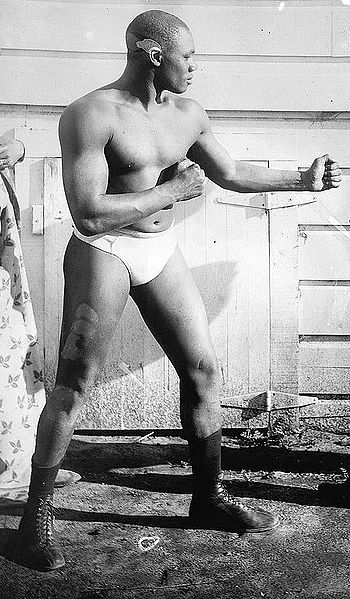Sam Langford KOs Battlin’ Jim Johnson
Tuesday, Hlis ntuj nqeg 12, 1916, Sam Langford defended the “Dawb lias ntiaj teb Heavyweight Boxing Championship”, which he won from Sam McVea in February 1916. Ntawm 1904 thiab 1919, the best African-American boxers, or black Canadians like Langford, were stuck fighting each other for “Colored” Championship.
If a white fighter did fight them, it was only to develop their own reputation to fight the current champion. Peter Jackson was the uncrowned champion of his era. “Gentlemen” Jim Corbett fought Jackson to prove himself worthy to fight John L. Sullivan. When Corbett won the title from John L. Sullivan, Txawm li cas los, he refused to “cross the color line” and fight Jackson.

Lub zoo Sam Langford los ntawm cov pej xeem sau ntawv
Sam Langford and other great fighters suffered this same fate even after the first African-American champion Jack Johnson won the world title in 1908. They were forced to fight each other for little money. Thiaj li, they fought far more often than they should to keep from starving while less talented fighters made more money.
Langford fought on average one or two fights a month through out 1916. Nyob rau lub hlis ntuj nqeg 1916, Langford was matched with Battlin’ Jim Johnson in New York’s Future City Athletic Club. Jim Johnson was a competent fighter but lost to all the best African-American fighters.
Johnson had the size and age advantage. Johnson stood 5’11’ thiab weighed 218 phaus. He was also 4 years younger at 29 xyoo.
Langford, who fought as low as welterweight (147 phaus), sawv 5’06” thiab weighed 210 pounds for this fight. Txawm li cas los, Langford’s skill level far surpassed Jim Johnson’s.
Johnson was game and tried to strike Langford with some heavy blows. He ended up hitting a lot of air and very little of Langford. Langford would move slightly out of the way and counter with his much faster strikes.
Despite Langford’s dominance, the match was headed for a twelve-round draw since decisions were not allowed in New York at the time. Langford ended Johnson’s hope of hanging on for the final bell, when he hit Johnson with a left to the belly. As Johnson’s diaphragm collapsed and he showed obvious signs of distress, Langford ended his night with a right cross to the jaw.

Jim Johnson’s 1913 Passport Photo from the Public Domain
Langford continued fighting until 1922, when he was almost 40 xyoo. He never secured a fight with Johnson or his successors. Tus “color barrier” was used to protect the champions from the most dangerous contender at the time.
Langford, who was born March 4, 1883, in Nova Scotia lived until a couple months before his 73rd birthday on January 12, 1956.
Ironically, Jim Johnson did secure a title fight with Jack Johnson. In the first title fight between black fighters, Johnson fought Jack Johnson. Jack Johnson was in exile in Europe at the time. Newspapers reported that the draw looked to be an exhibition between the two men.
Jim Johnson was going to fight Sam Langford once again in Lowell, Massachusetts in late 1918 but the Spanish flu pandemic caused the fight to be delayed. On his way to the site, Johnson contracted the Spanish flu and spent several days in a Danville, Virginia hospital. Johnson died from the flu and resulting pneumonia on November 6, 1918.
Did Sam Langford get a raw deal? Vim li cas los yog vim li cas ho tsis? Koj tuaj tawm tswv yim lossis nug ib lo lus nug hais txog qhov no lossis muaj nqe lus hauv qab no saib hauv qab no lossis rau ntawm kuv Facebook phab los sis Twitter profile.
Qhov chaw: St. Louis Dispatch tom qab, Lub ib hlis ntuj 4, 1916, p. 16 thiab St. Louis Star-zaug, Hlis ntuj nqeg 13, 1916 ib tsab, p. 13
Pin It

